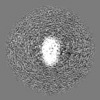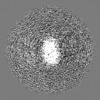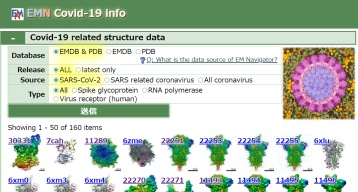[English] 日本語
 Yorodumi
Yorodumi- EMDB-50235: Human divalent metal transporter 1 (DMT1/SLC11A2) in complex with... -
+ Open data
Open data
- Basic information
Basic information
| Entry |  | |||||||||
|---|---|---|---|---|---|---|---|---|---|---|
| Title | Human divalent metal transporter 1 (DMT1/SLC11A2) in complex with manganese, in an occluded state | |||||||||
 Map data Map data | ||||||||||
 Sample Sample |
| |||||||||
 Keywords Keywords | Iron transport / Manganese transport / Transition metal transport / Divalent metal transport / Metal transport / Transporter / Membrane protein / SLC / Iron uptake / Iron homeostasis / LeuT fold / Small membrane protein / TRANSPORT PROTEIN | |||||||||
| Function / homology |  Function and homology information Function and homology informationvanadium ion transmembrane transporter activity / vanadium ion transport / paraferritin complex / Defective SLC11A2 causes hypochromic microcytic anemia, with iron overload 1 (AHMIO1) / lead ion transmembrane transporter activity / lead ion transport / nickel cation transmembrane transporter activity / transition metal ion transmembrane transporter activity / solute:proton symporter activity / : ...vanadium ion transmembrane transporter activity / vanadium ion transport / paraferritin complex / Defective SLC11A2 causes hypochromic microcytic anemia, with iron overload 1 (AHMIO1) / lead ion transmembrane transporter activity / lead ion transport / nickel cation transmembrane transporter activity / transition metal ion transmembrane transporter activity / solute:proton symporter activity / : / cadmium ion transmembrane transport / Metal ion SLC transporters / nickel cation transport / manganese ion transport / detection of oxygen / cadmium ion transmembrane transporter activity / manganese ion transmembrane transporter activity / copper ion transmembrane transporter activity / iron import into cell / cobalt ion transport / cobalt ion transmembrane transporter activity / retromer complex binding / ferrous iron transmembrane transporter activity / iron ion transmembrane transporter activity / zinc ion transmembrane transporter activity / iron ion transmembrane transport / copper ion transport / basal part of cell / vacuole / response to iron ion / heme biosynthetic process / dendrite morphogenesis / erythrocyte development / cadmium ion binding / trans-Golgi network / brush border membrane / iron ion transport / Iron uptake and transport / recycling endosome / multicellular organismal-level iron ion homeostasis / recycling endosome membrane / apical part of cell / late endosome membrane / late endosome / extracellular vesicle / cellular response to oxidative stress / cytoplasmic vesicle / early endosome membrane / intracellular iron ion homeostasis / mitochondrial outer membrane / learning or memory / early endosome / response to hypoxia / lysosome / endosome membrane / apical plasma membrane / lysosomal membrane / perinuclear region of cytoplasm / cell surface / Golgi apparatus / mitochondrion / nucleus / membrane / plasma membrane / cytoplasm Similarity search - Function | |||||||||
| Biological species |  Homo sapiens (human) Homo sapiens (human) | |||||||||
| Method | single particle reconstruction / cryo EM / Resolution: 3.6 Å | |||||||||
 Authors Authors | Liziczai M / Dutzler R | |||||||||
| Funding support |  Switzerland, 1 items Switzerland, 1 items
| |||||||||
 Citation Citation |  Journal: Nat Commun / Year: 2025 Journal: Nat Commun / Year: 2025Title: Structural basis for metal ion transport by the human SLC11 proteins DMT1 and NRAMP1. Authors: Márton Liziczai / Ariane Fuchs / Cristina Manatschal / Raimund Dutzler /  Abstract: Iron and manganese are essential nutrients whose transport across membranes is catalyzed by members of the SLC11 family. In humans, this protein family contains two paralogs, the ubiquitously ...Iron and manganese are essential nutrients whose transport across membranes is catalyzed by members of the SLC11 family. In humans, this protein family contains two paralogs, the ubiquitously expressed DMT1, which is involved in the uptake and distribution of Fe and Mn, and NRAMP1, which participates in the resistance against infections and nutrient recycling. Despite previous studies contributing to our mechanistic understanding of the family, the structures of human SLC11 proteins and their relationship to functional properties have remained elusive. Here we describe the cryo-electron microscopy structures of DMT1 and NRAMP1 and relate them to their functional properties. We show that both proteins catalyze selective metal ion transport coupled to the symport of H, but additionally also mediate uncoupled H flux. Their structures, while sharing general properties with known prokaryotic homologs, display distinct features that lead to stronger transition metal ion selectivity. | |||||||||
| History |
|
- Structure visualization
Structure visualization
| Supplemental images |
|---|
- Downloads & links
Downloads & links
-EMDB archive
| Map data |  emd_50235.map.gz emd_50235.map.gz | 25.5 MB |  EMDB map data format EMDB map data format | |
|---|---|---|---|---|
| Header (meta data) |  emd-50235-v30.xml emd-50235-v30.xml emd-50235.xml emd-50235.xml | 18.4 KB 18.4 KB | Display Display |  EMDB header EMDB header |
| FSC (resolution estimation) |  emd_50235_fsc.xml emd_50235_fsc.xml | 6.3 KB | Display |  FSC data file FSC data file |
| Images |  emd_50235.png emd_50235.png | 37.9 KB | ||
| Masks |  emd_50235_msk_1.map emd_50235_msk_1.map | 27 MB |  Mask map Mask map | |
| Filedesc metadata |  emd-50235.cif.gz emd-50235.cif.gz | 6.7 KB | ||
| Others |  emd_50235_half_map_1.map.gz emd_50235_half_map_1.map.gz emd_50235_half_map_2.map.gz emd_50235_half_map_2.map.gz | 25 MB 25 MB | ||
| Archive directory |  http://ftp.pdbj.org/pub/emdb/structures/EMD-50235 http://ftp.pdbj.org/pub/emdb/structures/EMD-50235 ftp://ftp.pdbj.org/pub/emdb/structures/EMD-50235 ftp://ftp.pdbj.org/pub/emdb/structures/EMD-50235 | HTTPS FTP |
-Validation report
| Summary document |  emd_50235_validation.pdf.gz emd_50235_validation.pdf.gz | 818.5 KB | Display |  EMDB validaton report EMDB validaton report |
|---|---|---|---|---|
| Full document |  emd_50235_full_validation.pdf.gz emd_50235_full_validation.pdf.gz | 818.2 KB | Display | |
| Data in XML |  emd_50235_validation.xml.gz emd_50235_validation.xml.gz | 12.7 KB | Display | |
| Data in CIF |  emd_50235_validation.cif.gz emd_50235_validation.cif.gz | 16.2 KB | Display | |
| Arichive directory |  https://ftp.pdbj.org/pub/emdb/validation_reports/EMD-50235 https://ftp.pdbj.org/pub/emdb/validation_reports/EMD-50235 ftp://ftp.pdbj.org/pub/emdb/validation_reports/EMD-50235 ftp://ftp.pdbj.org/pub/emdb/validation_reports/EMD-50235 | HTTPS FTP |
-Related structure data
| Related structure data |  9f6nMC  9f6oC  9f6pC 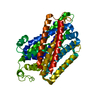 9f6qC M: atomic model generated by this map C: citing same article ( |
|---|---|
| Similar structure data | Similarity search - Function & homology  F&H Search F&H Search |
- Links
Links
| EMDB pages |  EMDB (EBI/PDBe) / EMDB (EBI/PDBe) /  EMDataResource EMDataResource |
|---|
- Map
Map
| File |  Download / File: emd_50235.map.gz / Format: CCP4 / Size: 27 MB / Type: IMAGE STORED AS FLOATING POINT NUMBER (4 BYTES) Download / File: emd_50235.map.gz / Format: CCP4 / Size: 27 MB / Type: IMAGE STORED AS FLOATING POINT NUMBER (4 BYTES) | ||||||||||||||||||||||||||||||||||||
|---|---|---|---|---|---|---|---|---|---|---|---|---|---|---|---|---|---|---|---|---|---|---|---|---|---|---|---|---|---|---|---|---|---|---|---|---|---|
| Projections & slices | Image control
Images are generated by Spider. | ||||||||||||||||||||||||||||||||||||
| Voxel size | X=Y=Z: 1.302 Å | ||||||||||||||||||||||||||||||||||||
| Density |
| ||||||||||||||||||||||||||||||||||||
| Symmetry | Space group: 1 | ||||||||||||||||||||||||||||||||||||
| Details | EMDB XML:
|
-Supplemental data
-Mask #1
| File |  emd_50235_msk_1.map emd_50235_msk_1.map | ||||||||||||
|---|---|---|---|---|---|---|---|---|---|---|---|---|---|
| Projections & Slices |
| ||||||||||||
| Density Histograms |
-Half map: #2
| File | emd_50235_half_map_1.map | ||||||||||||
|---|---|---|---|---|---|---|---|---|---|---|---|---|---|
| Projections & Slices |
| ||||||||||||
| Density Histograms |
-Half map: #1
| File | emd_50235_half_map_2.map | ||||||||||||
|---|---|---|---|---|---|---|---|---|---|---|---|---|---|
| Projections & Slices |
| ||||||||||||
| Density Histograms |
- Sample components
Sample components
-Entire : Complex of DMT1 with manganese ion
| Entire | Name: Complex of DMT1 with manganese ion |
|---|---|
| Components |
|
-Supramolecule #1: Complex of DMT1 with manganese ion
| Supramolecule | Name: Complex of DMT1 with manganese ion / type: complex / ID: 1 / Parent: 0 / Macromolecule list: #1 |
|---|---|
| Source (natural) | Organism:  Homo sapiens (human) Homo sapiens (human) |
| Molecular weight | Theoretical: 65.6 kDa/nm |
-Macromolecule #1: Natural resistance-associated macrophage protein 2
| Macromolecule | Name: Natural resistance-associated macrophage protein 2 / type: protein_or_peptide / ID: 1 / Number of copies: 1 / Enantiomer: LEVO |
|---|---|
| Source (natural) | Organism:  Homo sapiens (human) Homo sapiens (human) |
| Molecular weight | Theoretical: 71.93818 KDa |
| Recombinant expression | Organism:  Homo sapiens (human) Homo sapiens (human) |
| Sequence | String: MSRKKQLKTE AAPHCELKSY SKNSATQVST MVLGPEQKMS DDSVSGDHGE SASLGNINPA YSNPSLSQSP GDSEEYFATY FNEKISIPE EEYSCFSFRK LWAFTGPGFL MSIAYLDPGN IESDLQSGAV AGFKLLWILL LATLVGLLLQ RLAARLGVVT G LHLAEVCH ...String: MSRKKQLKTE AAPHCELKSY SKNSATQVST MVLGPEQKMS DDSVSGDHGE SASLGNINPA YSNPSLSQSP GDSEEYFATY FNEKISIPE EEYSCFSFRK LWAFTGPGFL MSIAYLDPGN IESDLQSGAV AGFKLLWILL LATLVGLLLQ RLAARLGVVT G LHLAEVCH RQYPKVPRVI LWLMVELAII GSDMQEVIGS AIAINLLSVG RIPLWGGVLI TIADTFVFLF LDKYGLRKLE AF FGFLITI MALTFGYEYV TVKPSQSQVL KGMFVPSCSG CRTPQIEQAV GIVGAVIMPH NMYLHSALVK SRQVNRNNKQ EVR EANKYF FIESCIALFV SFIINVFVVS VFAEAFFGKT NEQVVEVCTN TSSPHAGLFP KDNSTLAVDI YKGGVVLGCY FGPA ALYIW AVGILAAGQS STMTGTYSGQ FVMEGFLNLK WSRFARVVLT RSIAIIPTLL VAVFQDVEHL TGMNDFLNVL QSLQL PFAL IPILTFTSLR PVMSDFANGL GWRIAGGILV LIICSINMYF VVVYVRDLGH VALYVVAAVV SVAYLGFVFY LGWQCL IAL GMSFLDCGHT VSISKGLLTE EATRGYVKAL EVLFQGPQGT EQKLISEEDL RGASMDEKTT GWRGGHVVEG LAGELEQ LR ARLEHHPQGQ REP UniProtKB: Natural resistance-associated macrophage protein 2 |
-Macromolecule #2: MANGANESE (II) ION
| Macromolecule | Name: MANGANESE (II) ION / type: ligand / ID: 2 / Number of copies: 1 / Formula: MN |
|---|---|
| Molecular weight | Theoretical: 54.938 Da |
-Experimental details
-Structure determination
| Method | cryo EM |
|---|---|
 Processing Processing | single particle reconstruction |
| Aggregation state | particle |
- Sample preparation
Sample preparation
| Buffer | pH: 7.4 |
|---|---|
| Grid | Model: Quantifoil R1.2/1.3 / Material: GOLD / Mesh: 300 / Support film - Material: CARBON / Support film - topology: HOLEY |
| Vitrification | Cryogen name: ETHANE-PROPANE / Chamber humidity: 100 % / Chamber temperature: 277 K / Instrument: FEI VITROBOT MARK IV |
- Electron microscopy
Electron microscopy
| Microscope | TFS KRIOS |
|---|---|
| Image recording | Film or detector model: GATAN K3 BIOQUANTUM (6k x 4k) / Number grids imaged: 1 / Average exposure time: 1.26 sec. / Average electron dose: 59.9 e/Å2 |
| Electron beam | Acceleration voltage: 300 kV / Electron source:  FIELD EMISSION GUN FIELD EMISSION GUN |
| Electron optics | C2 aperture diameter: 50.0 µm / Illumination mode: FLOOD BEAM / Imaging mode: BRIGHT FIELD / Nominal defocus max: 2.4 µm / Nominal defocus min: 1.0 µm / Nominal magnification: 130000 |
| Sample stage | Cooling holder cryogen: NITROGEN |
| Experimental equipment | 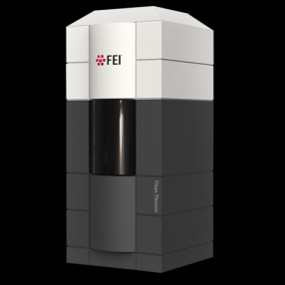 Model: Titan Krios / Image courtesy: FEI Company |
 Movie
Movie Controller
Controller


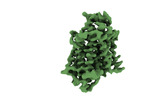



 Z (Sec.)
Z (Sec.) Y (Row.)
Y (Row.) X (Col.)
X (Col.)







